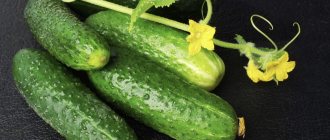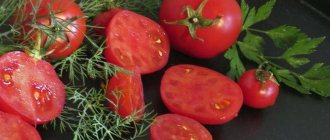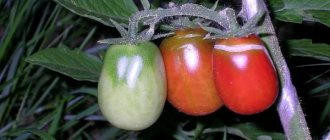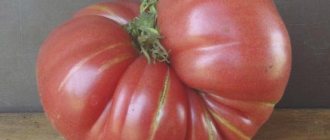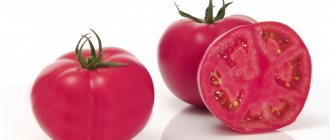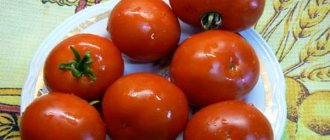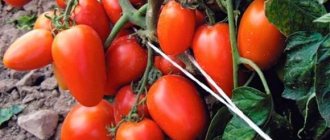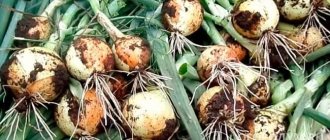The Wild Fred tomato appeared in 2000 thanks to the efforts of breeders from the USA. Agricultural technicians have embodied in the variety high productivity, keeping quality, transportability, and disease resistance.
| Height | Landing location | Ripening time | Fruit color | Fruit size | Origin | Fruit shape |
| short | Greenhouse, Open ground | Mid-season | Bicolor | Average | Variety | Flat-round |
Characteristics and description of the variety
New Big Dwarf and Carbon were used as parent varieties. Initially, the resulting new variety was called “Sleazy,” which translated means “sloppy.” But later, one of the founders of the project, Craig LeHoullier, renamed it Wild Fred in honor of his father.
The plant is low-growing, height no more than 60 cm.
Representatives of this series are often called columnar, since they have one or two weakly branched stems and therefore do not require regular pinching.
The Dwarf Wild Fred tomato is suitable for growing both indoors (greenhouses, greenhouses, balconies) and outdoors. The bush is compact. The stem is strong, thick, the leaves are dark green, large, similar to potato leaves. Up to 7-8 clusters are formed on one plant, each with 3-5 fruits.
Tomatoes are flat-round and when ripe can be dark pink or acquire a beautiful purplish-violet hue.
Sometimes a green spot appears near the petiole of a ripening fruit - a “crown”, indicating its high taste. The pulp is oily, the walls are thick.
The fruit is very juicy, has a pronounced aroma and a rich sweet taste with a slight but harmonious sourness. Very beautiful in cross section. There are few seeds.
Wild Fred tomatoes are intended for fresh consumption, as well as for making salads, juice, ketchup and other sauces.
Plant characteristics
Let's look at the main “parameters” of this bush - they will help you get a general idea of Wild Fred:
- The bushes can reach about 70 cm in height; they do not need to be tied up, which greatly simplifies the process of caring for the plant;
- Tomato fruits have an oval, less often round, shape. The lower and upper parts have slight “flattening”;
- Ripe fruits have a very unusual color - brown. Sometimes tomatoes may grow in a dark purple hue;
- The weight of ripe tomatoes is about 150 grams. It depends on the area where the plant is grown, as well as on the characteristics of care;
- Wild Fred's taste is very rich, the aroma is pronounced;
- The main purpose of this variety is its use in preparing various salads, where their taste parameters are revealed most fully;
- The pulp is often used to create homemade sauces, ketchups, etc.
Timing of sowing seeds
The tomato variety Gnome Wild Fred is considered mid-season. Technical maturity of the fruit occurs 110-125 days from germination. Seedlings should be sown 60-65 days before the planned planting in the ground, approximately in the first half of March. To improve germination, you can soak tomato seeds in a special growth stimulator, and when they hatch, sow them either directly into individual containers or in rows in one large box.
Some amateur gardeners germinate seeds on coconut tablets, vermiculite with water, and even in hydrogel. Each method has its own advantages and disadvantages.
Coconut tablets are quite expensive, but they save space when forcing seedlings. The hydrogel is capable of retaining moisture, so the sprouted seeds are not washed, but are immediately placed together with it in a container with soil. Soaking planting material in vermiculite fraction 0.5 or 1 mm (Micron or Super Fine) allows not only to reduce germination time, but also to obtain strong seedlings, especially if growth regulators are added to the water.
Features of cultivation
Caring for the Wild Thyme tomato is generally carried out according to standard rules. Tomato seedlings are planted in early spring and germinated in a lighted room for 60-65 days. After the final heat has been established, the seedlings are transferred to the beds and placed in prepared holes at intervals of 25-40 cm.
Tomato Wild thyme is recommended to be grown in beds after onions, carrots or legumes
In the process of growing a tomato variety, you need to pay attention to several points. The yield and size of the fruit largely depend on the quality of fertilizing and regularity of moisture.
Watering
Tomato Wild thyme does not respond well to waterlogged soil, but also does not like drought. It is necessary to moisten the plant twice a week or more often depending on the condition of the soil.
Water is added directly under the root, being careful not to irrigate the greenery of the bushes. Use the liquid, settled and lukewarm, and watering is carried out in the early morning or in the evening after sunset.
Top dressing
For abundant fruiting, tomato bushes require regular feeding. Throughout the season, wild thyme is fertilized several times:
- soon after planting in the ground - use an infusion of bird droppings or mullein with the addition of wood ash;
- ten days after the second flower cluster blooms, 15 g of complex mineral fertilizers with a predominance of potassium and phosphorus are added to 10 liters of organic solution;
- at the beginning of fruit ripening - they use the same phosphorus-potassium mixtures in combination with an infusion of organic matter, but apply only 500 ml of fertilizer for each bush;
- 14 days after the start of ripening - it is recommended to mix 20 g of superphosphate in 10 liters of Agricola-3 solution and water the plantings at the rate of 4 liters of fertilizer per 1 m2.
Attention! Timely application of fertilizing not only increases tomato yield, but also makes it more resistant to fungi.
Stepsoning
As the Wild Thyme tomato develops, pinching is carried out for the bushes. The plant is grown in 2-3 stems, and the remaining shoots are cut off as they appear.
It is necessary to remove the stepsons when the latter reach a length of about 5 cm. They need to be broken off at a distance of about 1 cm from the main stem so as not to harm it. By the beginning of fruit ripening, there should be no extra shoots on the tomato bushes.
Garter
When the Wild Thyme tomato reaches a height of more than 1 m, it begins to bend down to the soil under the weight of the fruit. To prevent tomatoes from falling to the ground, install wooden or metal stakes next to the bushes and tie the stems with thick thread or soft twine.
In a tomato greenhouse, you can install a trellis or mesh so as not to dig in a large number of supports
Loosening
Tomato Wild thyme develops well in breathable and light soil. To improve oxygen access to the roots of the bed, it is necessary to loosen it twice a month to a depth of 10 cm.
During the procedure, it is also recommended to remove weeds. They take away nutrients from the tomatoes and thicken the garden bed, in addition, they create conditions for the development of fungi.
Growing seedlings
There are no special requirements for caring for Wild Fred tomato seedlings. It is grown in the same way as other types of tomatoes.
First, the seeds are sown in one container filled with soil for seedlings. Until the first shoots appear, it is covered with film or glass, after which it is placed in a warm place, even without lighting.
Water with a spray bottle. When using a watering can, a crust may form on the surface, which will make it difficult for seeds to germinate.
As soon as the first shoots appear, the cover is removed. The box is moved to the window, otherwise the seedlings will stretch out, which will negatively affect the quality of the seedlings.
In the phase of one or two true leaves, the tomatoes are picked and transplanted into separate pots.
Water the seedlings from a watering can as the earthen ball dries out. Plants should not be over-watered, otherwise they may die from root rot, which is popularly called blackleg.
Tomato care tips
- It is recommended to grow tomatoes after crops such as carrots, onions or legumes. In order for the seedlings to grow strong, you need to prepare the soil in which you plant the seeds. Recipe: mix 1 bucket of humus with 1 bucket of soil from the garden and add 3 cups of wood ash.
- To protect outdoor plants from various diseases, pour a glass of wood ash into the holes before planting seedlings. It contains many microelements that will protect the root system from various diseases.
- Watering should not be done frequently. Irrigate after 3-5 days, at the root.
- Constantly loosen the soil and destroy weeds, they are one of the root causes of various diseases.
- It is recommended to grow seedlings in pots or special cups. The tomatoes will have a well-developed root system, which will allow them to quickly take root when transplanted into open ground.
- Despite the resistance of the tomato, it can be susceptible to:
- late blight. You can fight with the drug “Barrier”. For 10 l. 3 tablespoons of the drug are needed. If sprayed generously, the solution will be enough for 3 acres.
- Colorado potato beetle. To fight insects, use: “Colorado”, “Killer”, “Destroy”. The consumption of the drug is indicated on the packages.
- gnawing armyworm. The chemical preparation “Strela” will destroy this pest. To prepare the solution you will need: 10 liters. water and 50 grams of the drug.
Planting in the ground and caring for tomatoes
Seedlings are planted in the ground when the threat of return frosts has passed and the air temperature is not lower than 16-170C. The optimal planting density is 4-5 bushes per 1 m2, the distance between plants is at least 40-50 cm.
Despite the fact that the bush is relatively low-growing and standard, it should still be tied up. Otherwise, he may lie down under the weight of the fruit.
If there is no possibility of gartering, it is best to lay black agrofibre on the ground, on which the fruit will ripen. Moreover, it will not allow weeds to germinate, and at the same time will act as mulch, maintaining the necessary moisture.
Sleeping Lady (from a private owner)
I searched three websites of seed manufacturers and didn’t find a single determinant bicolor. I grew it myself from stunted plants.
Sleeping lady.
Sweet tomatoes, approximately 70-100 g each, bush up to 50 cm high.
Advantages
Those who have already tried to grow the Wild Fred tomato in their gardens and summer cottages have noted its advantages over other varieties.
- Unpretentiousness. Sets fruit even with irregular watering. This makes it suitable for growing in summer cottages, when the owners appear only on weekends.
- Endurance. The plant can tolerate temperature changes and even return frosts in June. To protect it, it is enough to cover it with agrofibre.
- High yield. With proper care, you can get 4-5 kg of tomatoes from one bush.
- Good transportability. Fruits tolerate transportation normally if they were picked at the stage of technical ripeness. Their skin is resistant to cracking.
- Easy care. The bushes are compact and do not need to be formed. Stepchildren grow inactively, but the main stems should still be tied up.
- Possibility of growing indoors. The Wild Fred tomato bears fruit even at home, for example, when cultivated on a balcony or loggia.
The list of advantages can be quite long. After all, every lover finds in this variety those advantages that appeal to him specifically.
The wild ancestor of the tomato - a genomic reservoir for breeders
Thousands of years ago, people in South America began domesticating Solanum pimpinellifolium, a weed with small fruits with a strong aroma. Over time, this plant turned into S. lycopersicum - the modern cultivated tomato
Modern tomatoes are larger and easier to grow than their wild ancestors, but are less resistant to disease and environmental stresses such as drought and salty soil.
Boyce Thompson Institute researchers led by Zhangjun Fei created a high-quality reference genome for S. pimpinellifolium and discovered regions of the genome that underlie fruit taste, size and ripening, stress resistance and disease. The results were published in the journal Nature Communications on November 16.
“This reference genome will allow researchers and plant breeders to improve tomato traits such as fruit quality and stress tolerance,” Fey said, “for example, by helping to identify new genes in modern tomatoes, as well as reintroduce genes from S. pimpinellifolium that have been lost.” over time as S. lycopersicum was domesticated.”
Although other groups have previously sequenced S. pimpinellifolium, Fey said the new reference genome is more complete and accurate, thanks in part to advanced sequencing technologies that can read very long pieces of DNA.
"Older sequencing technologies that read short pieces of DNA can detect mutations, but cannot find structural variants such as insertions, inversions, duplications and deletions of large pieces of DNA," said Shan Wu, a postdoctoral fellow in Fei's lab and co-author of the paper.
“Many of the known properties of tomato are caused by structural variations, so we focused on them,” Fay said. “Design options are also understudied because they are more difficult to identify.”
Fay's team compared its S. pimpinellifolium reference genome with the genome of a cultivated tomato called Heinz 1706 and found more than 92,000 structural variants.
The researchers then screened the tomato pangenome, a database of genomes from more than 725 cultivated and closely related wild tomatoes, and identified structural variants associated with many important traits. For example, modern cultivated tomatoes have some genomic deletions that reduce the level of lycopene (a red pigment with nutritional value), as well as an insertion that reduces the sucrose content.
(Source: phys.org. Photo shows blueberry-sized fruits of Solanum pimpinellifolium, the wild ancestor of modern cultivated tomatoes. Photo credit: Scott Peacock and CM Rick Tomato Genetics Resource Center.)
Flaws
In addition to its advantages, the Wild Fred tomato has some minor disadvantages:
- Expensive seed material. There are only a few seeds in one package. For example, a bag containing 7-10 pieces costs 40 rubles (excluding delivery).
- Low keeping quality. Wild Fred tomatoes soften very quickly. Therefore, storing them is not recommended. Due to the large size, it is difficult to preserve whole fruits of this variety. But you can prepare juice for the winter, and also use them in crushed form as an additive to other types of preservation, for example, adjika or lecho.
- The need for tying. The stem of the plant cannot withstand the weight of several clusters with ripening fruits, therefore, if it is not tied up in time, it spreads along the ground, which can negatively affect the quality and appearance of the tomatoes.
All of the above disadvantages can be easily circumvented. Many people consider Wild Fred tomato seeds to be relatively expensive. But it’s worth thinking about: how many bushes do you need for a summer house? A dozen is enough, and even with irregular care they will be able to recoup the cost of the seeds, delighting with a bountiful harvest.
Low keeping quality is not a problem. In winter, homemade natural tomato juice is always held in high esteem. Ripe tomatoes can also be used in canning recipes that require tomato dressing.
Does it need to be tied up? Not necessary. As was already written above, it is enough to lay black agrofibre and let the crop ripen on it.
Advantages and disadvantages of the variety
The Wild Thyme tomato is in demand among gardeners due to its good taste. But before planting a variety, it is necessary to comprehensively study its advantages and disadvantages.
| Pros: · large and fleshy fruits; · sweet pleasant taste; · unusual colors of tomatoes; · early ripening; · equally well suited for vegetable gardens and greenhouses; · has a fairly high immunity to pests and fungi; · grows to an average height of 1.2 m and does not require complex gartering. | Minuses: · at the seedling stage demonstrates high sensitivity to drafts; · with uneven watering, the fruits crack; · poorly suitable for preservation and heat treatment; · suffers from late blight and the Colorado potato beetle; · average yield. |
Wild thyme is not a fussy species, but requires minimal attention from the gardener.
Transplanting tomatoes into open ground
In mid-May, the bushes are transplanted into the greenhouse. The open space of the site is ready to receive young plantings only in early June.
Wild Rose seedlings are transplanted into the greenhouse in mid-May
- Preparation of beds begins with digging, removing weeds, and loosening.
- The soil is moistened and fertilizer is applied to the holes.
- Near the holes, stakes are driven in and the stems are tied to them. This procedure is performed precisely at this stage, and not at the moment when the plant has already grown. For this purpose, strong and long supports are selected.
Maintaining the correct distance between bushes is one of the key points in growing a variety. It must be at least 60 cm.
Important cultivation techniques
Gardeners begin sowing tomato seeds of the Wild Rose variety in early March. Before the process, the seeds are disinfected in an aqueous solution of potassium permanganate. Then light and fertile soil is prepared. Before planting, the soil is heated, thereby killing harmful bacteria. The finished seeds are placed on moist soil, then sprinkled with a small layer of peat or garden soil.
In order for tomato sprouts to sprout faster, cover the container with the plantings with film and put it in a warm place. After 5-6 days, the shelter is removed, the box with young seedlings is placed in a well-lit place. The best temperature for tomato shoots is +22°С…+24°С.
Young plants not only need to be ventilated and warmed; for full growth, the crop requires periodic feeding
At the moment when the first pair of true leaves appears on the bushes, the seedlings are picked (transplanted). To do this, you need to prepare separate containers. Young plantings should grow in a bright place; before planting the plants in the main growth area, the tomatoes are hardened off. The bushes are taken out for a short time into a greenhouse or closed loggia several times a week.
The plant is responsive to organic matter, so 2 feedings are enough for the entire season.
Young plants are not only ventilated and warmed, but for full growth the crop requires periodic feeding. Aqueous solutions of mineral fertilizers can be used as a growth enhancer. From mid-May, tomato bushes begin to be transplanted into greenhouses. Each hole dug for bushes is filled with a small amount of wood ash and complex fertilizer.
Considering that the bushes of the Wild Rose variety grow tall, the crop should be planted at a distance of 60-70 cm from each other. It is better to garter plants immediately after planting the seedlings in a permanent place; if possible, the bush is allowed to run along a trellis. For better air exchange, the lower leaves of the plant are torn off.
The plant is responsive to organic matter, so 2 feedings are enough for the entire season. This variety is resistant to many diseases, but preventive measures will help you get the expected harvest of vegetables.
Caring for the variety after transplantation
It is enough to feed tomatoes twice a season, and water them with warm water once a week. After each watering, the bed is loosened so that air can flow to the roots.
Several times during the summer the stepsons break off. The bush needs to be formed: one or two branches are left, all the rest are removed. Ignoring pruning leads to the active development of greenery to the detriment of the harvest.
Maturation occurs unevenly. Ripe samples are torn off, others continue to grow. Tomatoes of this variety successfully ripen indoors in the fall, even if they were picked green.
Ripening occurs unevenly - ripe fruits are picked, green ones ripen
